Legislature Finishes a Tough Session for Environment
Sometimes, you win by not losing. That describes, somewhat, how the environment fared in Texas's 88th Legislative Session.
San Antonio emerged with its tree and aquifer protection ordinances intact. And come September 1st, we will, effectively, be the only large city in the state with an extra-territorial jurisdiction.
Noteworthy was the volume of bills aimed at dismantling environmental regulations. Fossil-fueled power generation won and clean energy lost. Cities lost much of their authority to enact protections for their citizens. But there were bright spots, including $1 billion for new parks.
Warblers spared from clearcutting bill
Time ran out on House Bill 2239, the Ashe juniper clearcutting bill. Although it passed out of the House and a Senate committee, it failed to get a vote in the Senate before the end-of-session deadline.
Thanks to all who contacted state Senators and Representatives in opposition to this bill. As originally drafted, it would have allowed developers to clearcut the trees. But after a long Senate committee hearing where people turned out in droves to oppose the bill, it was amended so only homeowners could use it to remove the trees. It still failed.
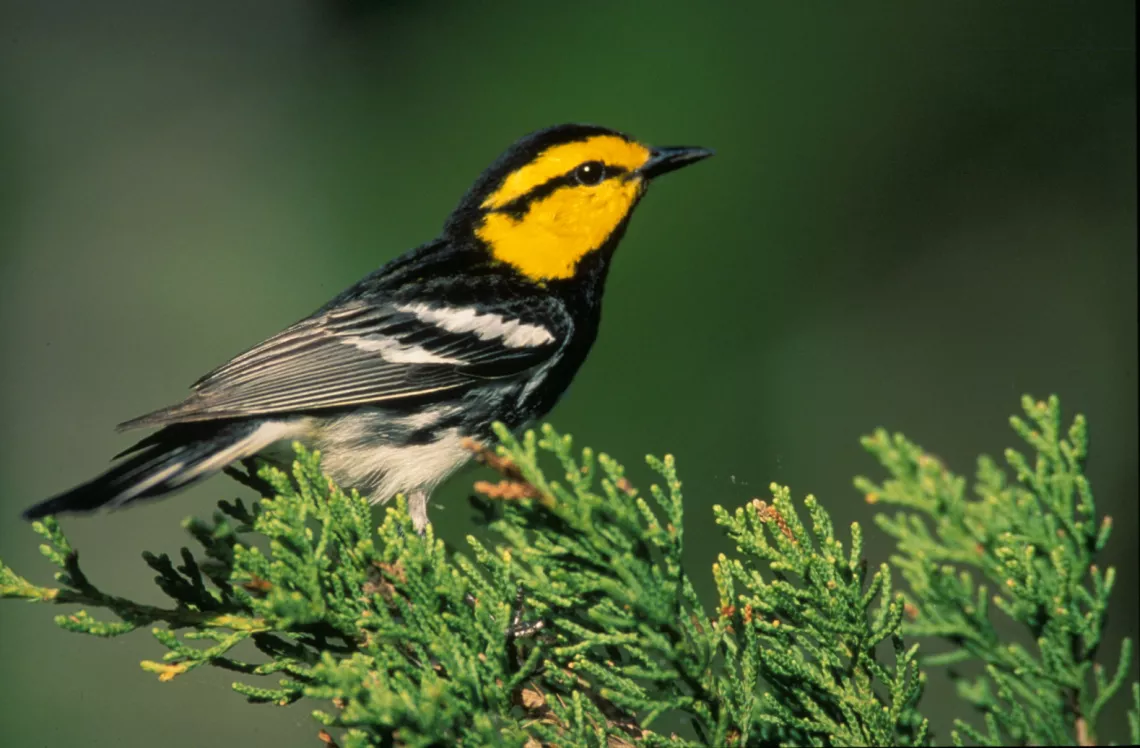
Maslowski, Steve/U.S. Fish and Wildlife Service
"Paving over the aquifer" bill killed in House
A bill that would have increased contamination in your drinking water was killed on a point-of-order by Dallas Democrat John Bryant. SB 2037 would have nullified impervious cover limits in SA's Edwards Aquifer Recharge Zone Protection ordinance and stopped counties from enacting development codes promoting "the health, safety, morals, or general welfare of the county and the safe, orderly, and healthful development of the ... county".
Senator Bettencourt revived it by tacking it onto another bill near the end of the session, but that amendment was rejected by a conference commitee.
The "Ending Local Freedom Act"
A bill to limit the power of cities to enact environmental, consumer, and worker protections passed and was sent to Greg Abbott. It amounts to a takeover of local governments by the legislature.
In a similar vein, the Governor recently signed SB 784 prohibiting cities from regulating greenhouse gas emissions.
Landmark energy efficiency bill falls short
As the deadline to get Senate bills out of House committees approached Friday night, the fate of a historic energy efficiency bill became clear: very powerful corporate utilities like Oncor, CenterPoint, and AEP Texas had killed the best chance to control rising utility bills and protect Texas families from what will be a huge increase in costs in the coming years. Read more in the story Utilities Extinguish Energy Savings Bill, Paving the Way to Higher Costs for Texas Families.
Parks get a billion dollar investment
SB 1648 and SJR 74 establish the Centennial Parks Conservation Fund with $1 billion to help create new state parks. It’s a historic investment that will allow the Texas Parks and Wildlife Department to create dozens of new parks in the coming decades. It hinges on voter approval of a constitutional amendment this fall.
Corporate giveaway program excludes clean energy
HB 5, which recreates a massive corporate polluter subsidy, is on its way to Greg Abbott's desk. It revives a program that has given billions of dollars to polluting industries through school property tax abatements. Unlike its predecessor, known as "Chapter 313", HB 5 excludes solar and wind energy projects from receiving the tax breaks. See Late deal sends new economic incentives for businesses to governor for more.
"Don't Say Pollution" bill sent to Abbott
TCEQ, which was deemed a “reluctant regulator” by the Sunset Commission, now has authority to ignore citizen reports about polluters. SB 471 gives discretion to the TCEQ to not investigate complaints from members of the public about potential violations. It passed and awaits Greg Abbott's signature.
For more, read The threat that could undo key program at TCEQ
Legislative updates by Richard Alles, Alamo Group Forests/Trees Conservation Leader; information also provided by Lone Star Chapter and Environment TexasThe Status of the Global Plastisphere
Our June general meeting features Andre Felton, M.S., discussing microplastic pollution and his research into its environmental and biological threats.
Tuesday, June 20th
6:00 pm
Meeting schedule
| Informal get-to-know-you | 6:00 pm to 6:15 pm |
| Announcements | 6:15 pm to 6:30 pm |
| Featured program | 6:30 pm to 8:00 pm |
Venue
This will be a hybrid meeting.
In-person location
William R. Sinkin Eco Centro, 1802 North Main Avenue
Map
Zoom meeting access info
- Meeting ID: 966 5254 0606
- Passcode: 377093
- Link: https://sierraclub.zoom.us/j/96652540606?pwd=UUVISUw3OHluQ2xsQk5IeENxeXFZdz09
Program topic
The global plastisphere is a marvel of human generation and a testament to the scale of our collective impact on the planet. In less than a century, we have created a novel biogeochemical cycle akin to natural occurring elements such as the water cycle, carbon cycle, and nitrogen cycle.
Following World War II, plastic production because an industrial commodity advertised to shape the future. And it has in many ways. Since then, there is not one facet of modern life that doesn’t involve or require a plastic polymer.
The other side of that equation is the amount of plastic waste production and consequential emersion into the natural environment. The magnitude of plastic waste is shifting to represent a selective pressure on microbes around the around. Additionally, these tiny compounds are an unknown component of the global carbon budget and climate heat model that we are recently coming to realize.
Our understanding of the global plastisphere is still in its infancy, but there are also innovative and exciting solutions that will require holistic perspectives of the global scale and human dimensions to be effective. The plastisphere is here to stay, but we must find the balance.
About our speaker
Andre Felton, M.S. is a doctoral candidate in the Integrative Biology department at the University of Texas at San Antonio. Currently, he works in Jeffrey Hutchinson’s lab investigating ephemeral freshwater systems and conducts research aimed at understanding the environmental and biological threats of microplastic pollution.
Additionally, in collaboration with a fellow UTSA doctoral student, he has developed novel methods to extract microplastics from both hail and sediment samples, and reported the first evidence of microplastics in hailstone formation and deposition. He was recently awarded the NISOD Teaching award and the NVC Excellence in Teaching award as an adjunct instructor for Alamo Colleges in San Antonio.
He is passionate about research to understand current and future biodiversity trends. He hopes to share that passion with minority-dominant communities and contribute to diversifying the natural sciences.
The Alamo Group of the Sierra Club holds its general meetings the 3rd Tuesday of most months. They're always free and open to the public. View videos of our past meetings on our YouTube channel or our Facebook page.
Vehicle Preparedness for Travel to Remote Areas, and Some Personal Bits
Surely other characters may think of more bits to carry but this is a start. We know there could be a problem or three on any trip. If we can't deal with those ourselves, no telling how long we might have to wait for help; some places could be days. We hope for passersby that might help with a problem, or take us out to a city. Then we have to pay $800 or whatever for a tow and more for repairs. Or, we could be the passersby that might be able to help others with a problem.
More water than we could possibly need
I carry 8-10 gals, mostly in a collection of Arizona Iced Tea jugs, which are sturdy with wide mouths and therefore easy to fill. Once gave a driver of a broken-down truck a bottle of water and a ride to a nearby town. Another time gave a bottle to a hiker on the Arizona Trail who had lost one. May need a wide-mouthed nalgene-type bottle which will fit under bathroom sink faucets in order to fill jugs.
Extra food and warm clothes
Suppose we have driven from our campsite to a dayhike trailhead with nobody else around, wonderful solitude. But then with a problem we are stuck. Might spend a night or two waiting for help or hike out. In addition to water, often the most critical requirement, surely would like to have some extra snacks. And stuff to provide a warmish bit of sleep away from our tent.
In Death Valley National Park near the east end of Titus Canyon road (picture below) I was following a car with a flat tire and the driver didn't know it. Finally he saw my blinking lights and stopped. Stood by and watched him change the tire on his rental car. He didn't need any real help, but he was an oldish guy with two likewise women. I asked, he said they had "a water bottle". But did they have any food? Warm clothing in case got stuck overnight? He was planning to simply drive through, said he had done it before. Thankfully he turned around.
Hiking mistakes: sure taught me a lesson or three
Headlamps: best carry two in our vehicle and two in our daypack. USB rechargeable ones are very durable now. Fully charge before/during a trip. We may not realize how important these could be until a situation arises.
Trekking poles: we are four-footed once again, very helpful on any terrain, both down and uphill. Our arms take some of the workload off the legs. Might need for hobbling back to our vehicle with a leg injury. Have hands out of the straps on tricky terrain, don't wanna be tangled in the poles and then do a fall head first.
Navigation: printed road maps of course. Hike route maps are easy to find, download and print. Phone navigation apps with OFFLINE maps are very useful, but practice with them ahead of time with cell service turned off. Google OFFLINE maps are good, assuming we download the right areas and these expire. But the latter can be rubbish or even dangerous for backcountry roads. Best two phones, with the same app and maps, in case one is lost or damaged, and both are fully charged before a hike.
Article with the above title in the April 2021 issue of this newsletter.
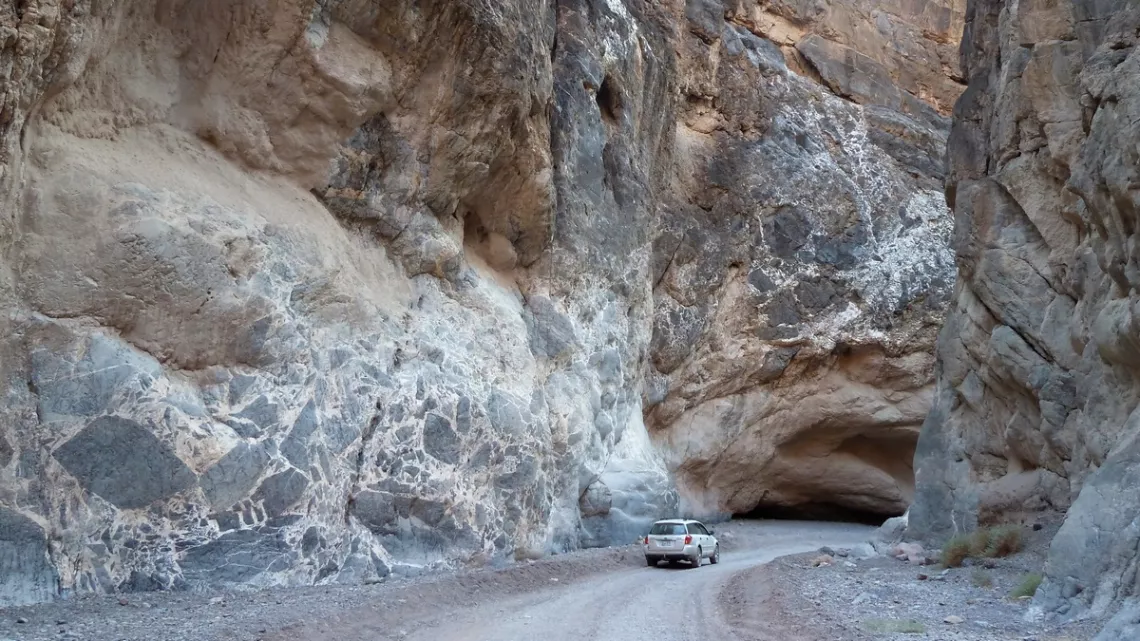
Road conditions
Do we have high clearance? 2WD or all-wheel drive? Many backcountry roads require high clearance vehicles even if there isn't a sign. And there may be a sign "Impassible When Wet"; likely not kidding, at least for 2WD. Some roads are signed "4WD required", which may be about SERIOUS rough/steep sections that really need a Jeep or whatever, might be dangerous simply with all-wheel drive. Or the latter could be sufficient if we are otherwise prepared, though not allowed, or maybe 4WD is including all wheel drive.
Tire problems
Full size spare wheel highly advised, not just the little factory spare (lesson story in next picture's caption). I store mine placed vertically in the back on driver's side. Better gas mileage than if placed on a roof rack and still have room to sleep on the right side of my Outback. Needed this at North Rim Grand Canyon 2019, cut the trip short. Could have plugged the leak if had been carrying a tire plug kit (2nd picture below). Used those number of times 45 yrs ago with a Land Cruiser on Padre Island, seemed easy as a youngster. Plugged a tire at Big Bend Ranch State Park 2021, was holding fine.
I carry a second jack and lug wrench with the spare wheel so don't have to excavate for those stored with the factory spare.
Condition of our tires
We might think the tires have another 10k+ miles on them, no problem, and tire shops are all around town. But are much more likely to have flats with marginal tires on rough dirt roads in remote areas.
On a 2021 trip with a van in North Dakota, Theodore Roosevelt National Park, we were having breakfast in Medora. Came out and a tire was flat. So glad it happened in town. The tires were rather well worn, should have replaced earlier. No cell service for us; a park ranger advised regards a tire shop and loaned his office phone. A few hours later luckily had new tires and was on the the road again.
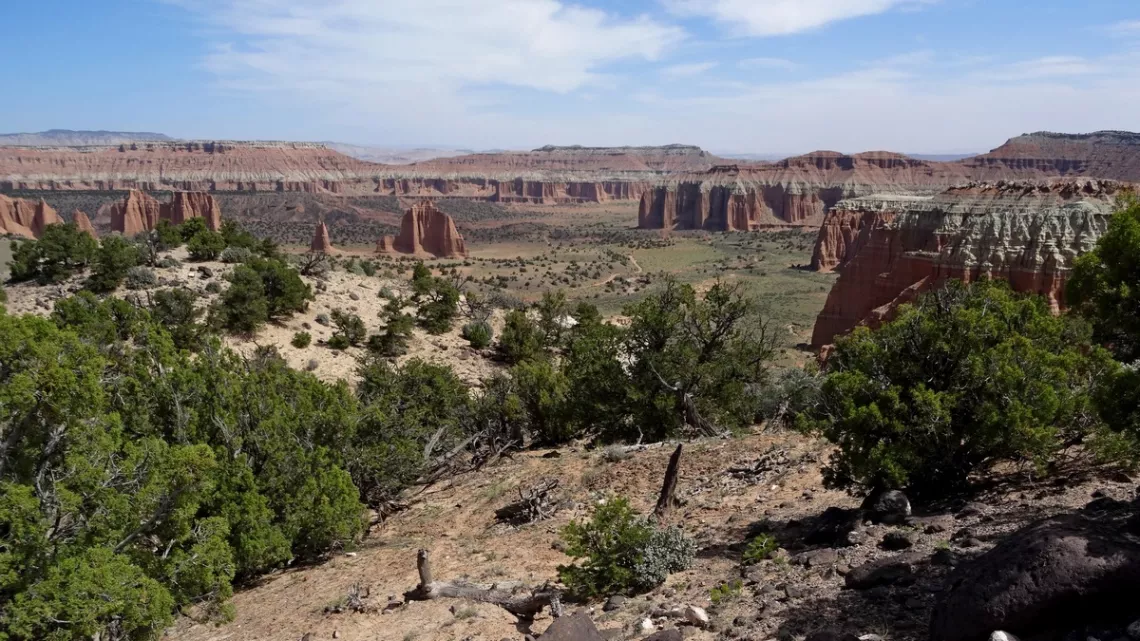
Tow strap and bumper tow hook
Most cars have tow bolts stored with the spare tire (next picture). These screw into ports on the bumpers. Best we find the tow bolt and the bumper ports so we understand how we would connect our tow strap and get a tow.
Once in Maine at a park backed off the parking area gravel pad and was stuck. Our Prius V has a tow bolt. I screwed it into the front bumper, attached my strap, and happily was able to impose upon someone for the little pull out.
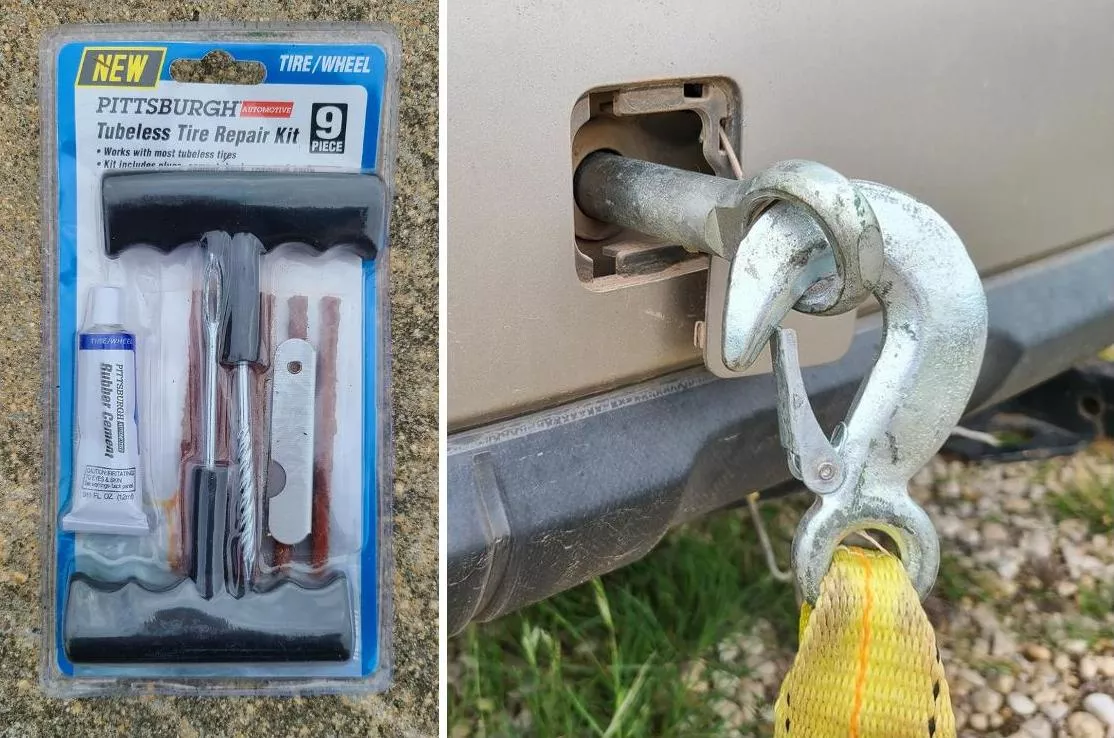
Tire inflator
Have an extension power cable to go with, so can reach around the car or to another vehicle. There are battery powered USB rechargeable inflators; these work fine for a low tire but maybe not for a full flat, and then take hours to recharge.
Tire valve tool and spare valves
In Utah 2021, middle of nowhere, stopped when the TPMS (Tire Pressure Management System) light came on. A tire half flat. Used my tire inflator, then heard a little hissing noise. Checked the valve with a drop of spit; it was leaking, and had lost the valve cap. Was going to replace the valve but then would have to fully re-inflate; then I realized the valve was loose, easily tightened (next picture). Best have caps on the valves to keep dirt out and in this case should have kept the valve from coming totally unscrewed and falling out.
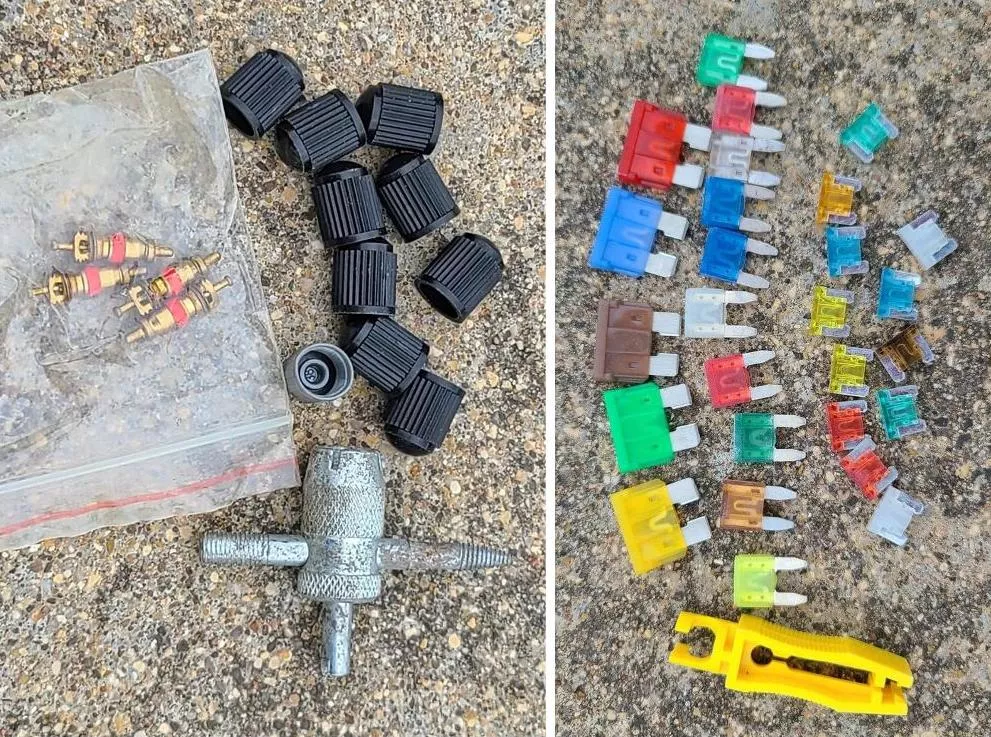
Fuses
Look at the fuses and hopefully read info about what is for what. Understand what physical size and amperage rating they are, and buy an assortment to carry in a toolbag pocket. Previous picture. Wikipedia has a good article.
Camping at Big Bend Ranch state park a buddy inflated an air mattress with an electric inflator plugged into my car's console outlet. Stopped working. Blown fuse. Figured out which fuse; only 10 amp, replaced. Found out the outlet at the rear of the car was on a 20 amp circuit. Used that instead, much safer for our preparedness. Very educational again.
Jumper cables and battery-powered jump starter
Hopefully the cables are long enough to reach between cars that can't be parked nose-to-nose. Jump starters (next picture) can work well if fully charged; charge before trips. I originally thought, the silly little battery in those things surely can't help a car battery. Learned the little battery charges capacitors which discharge to power the starter motor. Used a few times.
Multimeter and know the basics
Good grief the car won't start. Best to first check the battery voltage with a multimeter (next picture); should start if it is at least 11v or so. Low fluid level in the battery? For that add distilled water. Is there another problem, not simply a low battery? Significant corrosion on the terminals? There could be voltage drop across the corrosion, which would appear to be a low battery to the starter motor. Should be around 13v with engine off after driving a bit.
Recently helped a friend with starting problem. The voltage was 12v, should have started. No corrosion on the terminals and fluid levels fine. Maybe a marginal starter motor or solenoid? Started after a short charge.
Before trips check that the multimeter low battery indicator isn't on. And check continuity across the leads, then all should be ok. Here's a tutorial “mostly for beginners who are starting out in electronics and have no idea how to use a multimeter and how it can be useful".
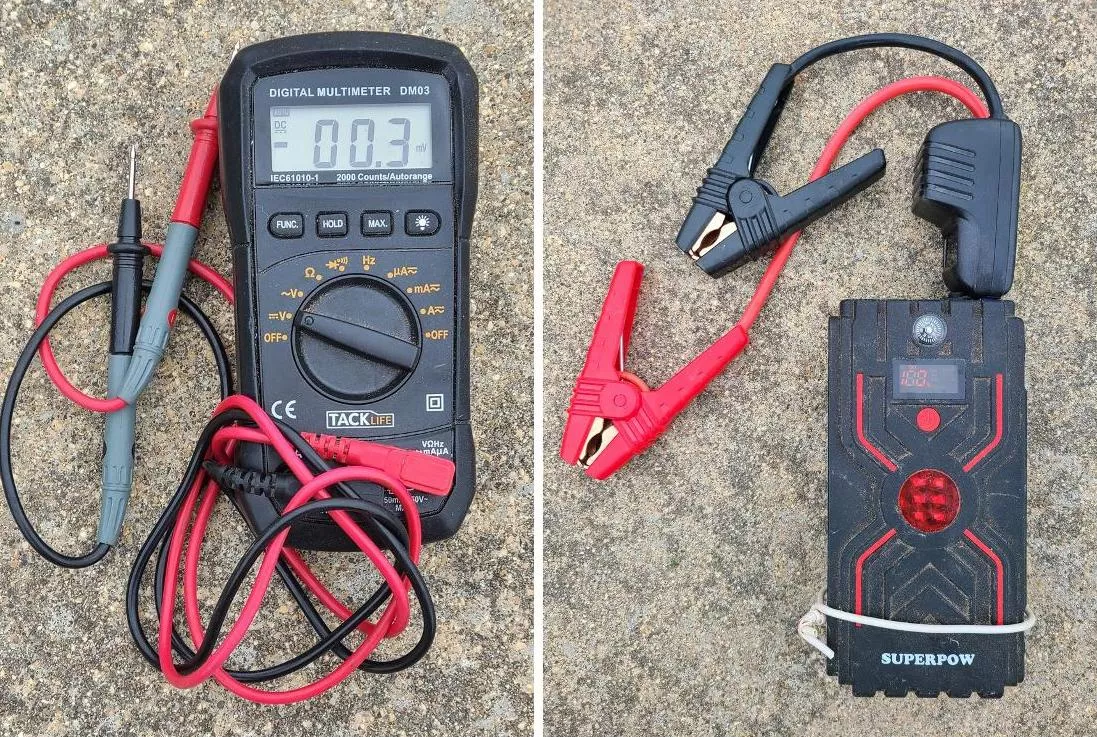
OBD (On Board Diagnostics) scanner
Not commonly carried. I didn't till once when the check engine light came on and cruise control was disabled, happily near home. WHAT THE HELL? Bought a scanner; it said the pollution control system had detected a gas tank leak. I had forgotten to screw the gas cap on till it clicked. Deleted the alert with the scanner and all was fine. These plug into a socket under the dashboard on driver's side. Same problem couple years later on a trip; used my scanner and found the same issue. Same solution. Here's a typical webpage about OBD scanners.
Bag of tools
Of course screwdrivers, wrenches, pliers, electrical tape. Have small/medium/large sizes. Channel lock, electrical and vise grip pliers. Does the car has metric or SAE bolt sizing? Likely metric these days. And socket set; can often get by with adjustable wrenches but not always. Try sockets on a few bolts to understand the sizing.
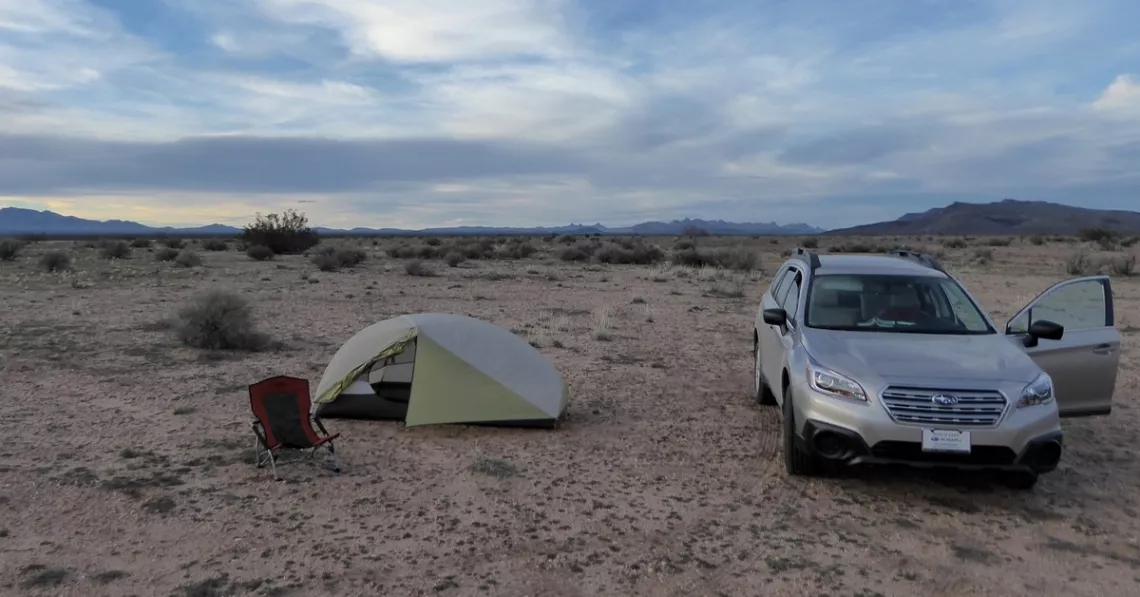
Solar panel and USB battery packs
I always have a 21 watt folding solar panel on my Outback dashboard connected to a 10,000 mAh battery pack. For charging cell phones etc. The panel will fully charge the battery in as little as a few hours if the sun is optimally angled to the panel. When one is fully charged I switch to another. Parking at trailheads I think about how to orient the car so the panel gets decent sun when I'm hiking. If really need to charge at a campsite I move the panel outside to eliminate the attenuation of the light by the windshield and optimally orient to the sun. Here's about what I bought a couple of.
On a backpacking trip around Mt. Rainier, 12 days, my buddy carried one of these panels. Last picture. We charged our phones at campsites. Rarely had cell service but used the phones for navigation and photography.
Keys
Surely we'll have more than one key. I keep one clipped in top of my daypack and another zipped in a pants pocket. And a 3rd in the car console. Earlier had been putting one key in unzippable pocket of cheap hiking pants. Walking around at-large campsites looking for free firewood on TWO TRIPS found my keys on the ground, had fallen out of the pocket. Wasn't even looking for them yet!
Once at a trailhead didn't properly close my Outback door; pressed the key button to lock. “Beep beep beep”, not locked. Opened door, got an item had forgotten, closed the door, “beep”, locked! Could have left the keys on the seat locked inside, later tested that, yes can happen. A software design problem with the car, our Prius won't do that. Important points found with a basic search: lock the car with a key, not with the door button. And: if the key battery is low the car might not detect it inside.
Have been leaving car windows open 2 inches at trailheads recently. In a pinch imagine could tie trekking poles together with paracord or a boot lace; reach through to opposite door and unlock, and the alarm goes off. I get the 3rd key out of the console, use that and alarm stops.
Lastly, other bits
Stored with my spare wheel in the back: fire extinguisher, small shovel, fireman's axe, folding saw, work gloves. Bunch of the other stuff is stored in a square bucket, which could be needed regards a fire or something.
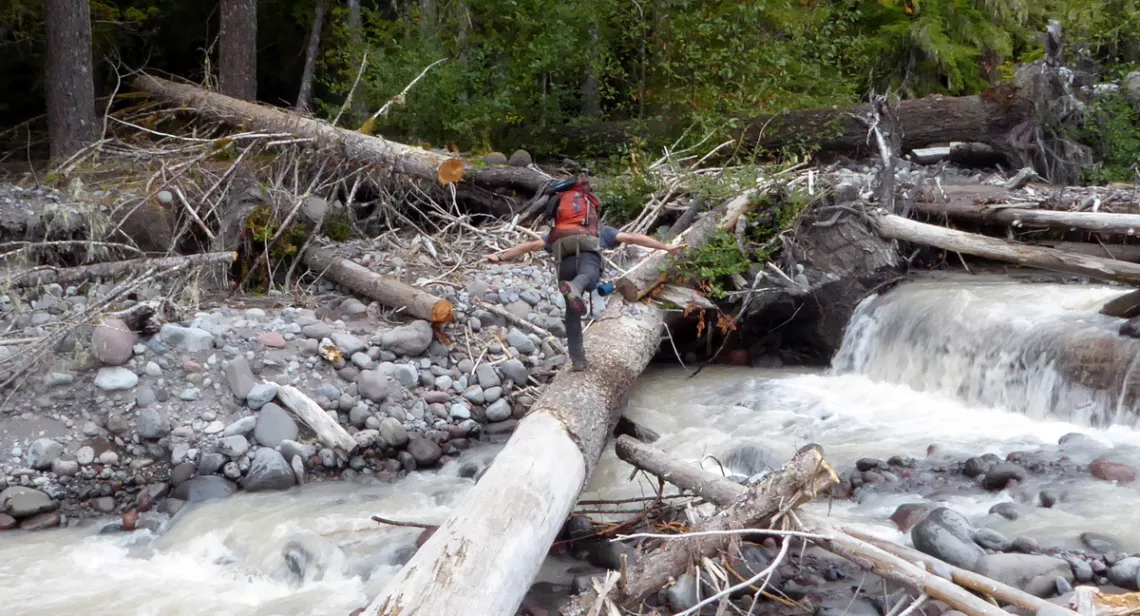
From the e-Mailbag
From time-to-time, the Alamo Group receives messages concerning local environmental issues. If you have thoughts on any of these issues, send us a message and we'll forward it to the writer.
The views and opinions expressed here are those of the authors individually and do not reflect the views or opinions of the Alamo Group or its members.
When One Almond Gulps 3.2 Gallons of Water
The New York Times recently published this thought-provoking opinion piece about the water crisis in the Western U.S..
submitted by Joan C.

Outings: The Call of the Wild
Visit the Alamo Sierra Club Outings page on Meetup for detailed information about all of our upcoming Sierra Club Outings.
The Alamo Sierran Newsletter
Richard Alles, Editor
Published by the Alamo Group of the Sierra Club, P.O. Box 6443, San Antonio, TX 78209, AlamoSierraClub.org.
The Alamo Group is one of 13 regional groups within the Lone Star Chapter of the Sierra Club.
Changed your contact information?
If you're not sure whether the Sierra Club has your current email address, send an email to Member Services with your name and address and/or member ID (see Locating Your Member ID) so they can add your email address to your member record.
Have you moved? Let us know by sending your old address, your new address and your member ID to: address.changes@sierraclub.org.
Go online for the latest news and events
 |